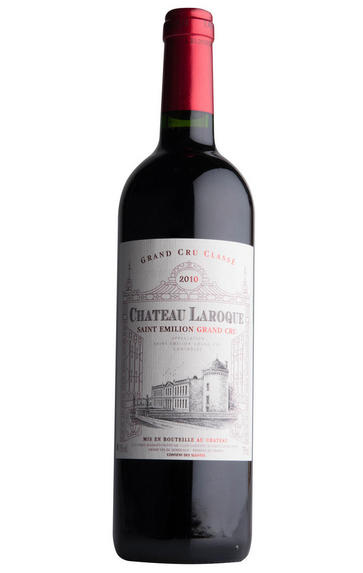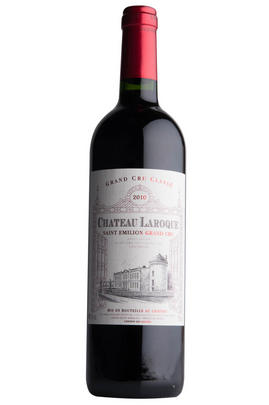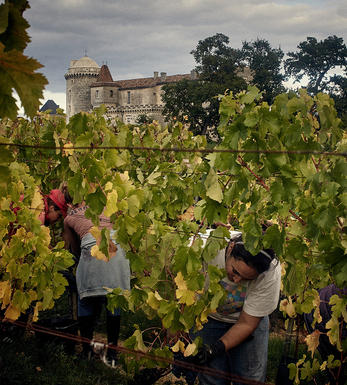
2010 Château Laroque, St Emilion, Bordeaux

Critics reviews
Very dark crimson. Pretty smart and rewarding, and very obviously right-bank Merlot. Spicy but with good appetising freshness on the end.
Janice Robinson
Steven Spurrier, Decanter (summer 2015)
About this WINE

Château Laroque
Château Laroque is a large St. Emilion estate famous for its stunning 18th century château as well as for the quality of its wines. It is owned by the Beaumartin family and was granted Grand Cru Classé status in 1996.
Its 61 hectares of vineyards (27 of which are used for the Grand Vin) are situated in the commune of St. Christophe des Bardes and it produces nearly 25,000 cases a year. The blend is predominately Merlot based and the wine is aged in oak barrels for 12 months. In the best years it is packed with ripe and plummy fruit supported by a framework of supple tannins and balanced acidity.

St Émilion
St Émilion is one of Bordeaux's largest producing appellations, producing more wine than Listrac, Moulis, St Estèphe, Pauillac, St Julien and Margaux put together. St Emilion has been producing wine for longer than the Médoc but its lack of accessibility to Bordeaux's port and market-restricted exports to mainland Europe meant the region initially did not enjoy the commercial success that funded the great châteaux of the Left Bank.
St Émilion itself is the prettiest of Bordeaux's wine towns, perched on top of the steep limestone slopes upon which many of the region's finest vineyards are situated. However, more than half of the appellation's vineyards lie on the plain between the town and the Dordogne River on sandy, alluvial soils with a sprinkling of gravel.
Further diversity is added by a small, complex gravel bed to the north-east of the region on the border with Pomerol. Atypically for St Émilion, this allows Cabernet Franc and, to a lesser extent, Cabernet Sauvignon to prosper and defines the personality of the great wines such as Ch. Cheval Blanc.
In the early 1990s there was an explosion of experimentation and evolution, leading to the rise of the garagistes, producers of deeply-concentrated wines made in very small quantities and offered at high prices. The appellation is also surrounded by four satellite appellations, Montagne, Lussac, Puisseguin and St. Georges, which enjoy a family similarity but not the complexity of the best wines.
St Émilion was first officially classified in 1954, and is the most meritocratic classification system in Bordeaux, as it is regularly amended. The most recent revision of the classification was in 2012

Merlot
The most widely planted grape in Bordeaux and a grape that has been on a relentless expansion drive throughout the world in the last decade. Merlot is adaptable to most soils and is relatively simple to cultivate. It is a vigorous naturally high yielding grape that requires savage pruning - over-cropped Merlot-based wines are dilute and bland. It is also vital to pick at optimum ripeness as Merlot can quickly lose its varietal characteristics if harvested overripe.
In St.Emilion and Pomerol it withstands the moist clay rich soils far better than Cabernet grapes, and at it best produces opulently rich, plummy clarets with succulent fruitcake-like nuances. Le Pin, Pétrus and Clinet are examples of hedonistically rich Merlot wines at their very best. It also plays a key supporting role in filling out the middle palate of the Cabernet-dominated wines of the Médoc and Graves.
Merlot is now grown in virtually all wine growing countries and is particularly successful in California, Chile and Northern Italy.


Buying options
Add to wishlist
Description
Ch. Laroque is a large St Emilion estate famous for its stunning 18th century château, as well as the quality of its wines. It is owned by the Beaumartin family and was granted Grand Cru Classé status in 1996. Its 61 hectares of vineyards (27 of which are used for the Grand Vin) are situated in the commune of St Christophe des Bardes and it produces nearly 25,000 cases a year.
From the cool, classic 2014 vintage, this Claret is fresh and balanced. The blend is Merlot-based and the wine is aged in French oak barrels for 12 months, giving a nice aroma of spice and wood smoke. The palate is fleshy with a hint of plum, the tannins fine and firm, leading to a generous finish. Drink now to 2029.
wine at a glance
Delivery and quality guarantee